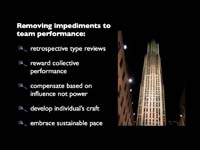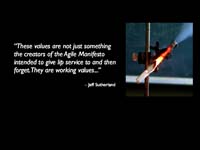Feedback on my proposed session at Agile 2012 on whether principled Agile practice is capable of creating workplaces and an industry more inviting of women software developers…
I could not agree more. There are many negative perceptions about software development these day in the US (off-shoring, hostile env, long hours, …). As a result, my friends at North Carolina State University tell me that overall CS enrollment is down. There was a similar event in Japan with the creation of the “Software Factory” in early 80s. I believe that they almost decimated their software industry. But how do we solve this? It has to start early as the career begins way before their first job. Leadership? If we want to maintain the industry, you bet.
Agile thought leaders came together in the first place to challenge the rest of us to empower individual contributors, elevate the role of craft and quality, cultivate collaborative ways of working, and create better, more valuable software products.
Following their lead, principled Agile practice is a determined process of honest observation and incremental improvement. It is dedicated, courageous advocacy for removing obstacles — an effort supported by analytics and a track record of improved performance.
The ambitions of this change don’t stop at a team or a set of engineering practices (though those are hard enough to accomplish). It is a change program within an organization.
We should see our mission is aligned with creating a software workplace and definition of the software developer inviting to articulate people, with diverse interests and points of views, who reflect our actual end users, and who want careers that have meaning and purpose.
I’ve never participated an agile adoption that didn’t ultimately set its sites on the larger company, the products that organization is building and why it is building them. I’ve never been part of a prolonged and dedicated agile adoption that didn’t bring developers closer to creative people outside the team, that didn’t make work a more rewarding place to show up each day.
Agile practitioners need to battle workplace cultures that discourage women and other talented people from entering and remaining in our field one dysfunction, one bully, one obstacle at a time, in one workplace at a time, because they are obstacles to collaboration and trust, disempower and burn out talented individual contributors, and distance us from our customers and end users.
I’m not saying this happens everywhere or that the changes are permanent. Widespread adoption brings with it mixed and often disappointing results. But enough of us need to drive for this change in enough of our shops, enough of the time that Agile remains a path to excellence for those of us capable of striving after it.
And by doing this we will create enough change to influence the rest of the industry. Agile adoption itself is an example of this kind of change.
Does this effort provide a clear path to success? Clearly not.
But is this approach capable of driving large and dramatic changes in companies and our industry? Yes.





























